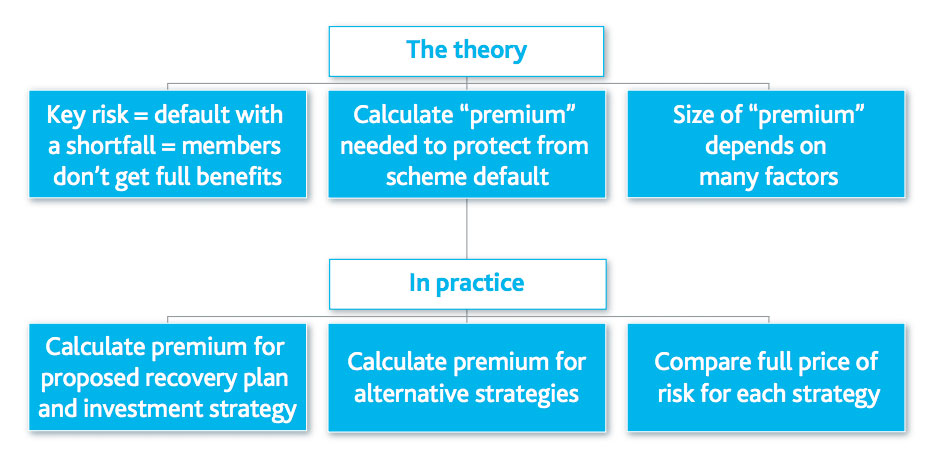Case Study
The C word (in the world of pensions)
29 Jun 2015 - Estimated reading time: 2 minutes
With our funding valuation coming to a conclusion in the first quarter of 2015, against a backdrop of what felt like a fundamentally new financial world (how long can gilt yields continue to limbo?), we felt it was time to take a fresh look at our approach to strategy.
And that’s what we did. Jamie Lindsay, Chair of Trustees British Polythene Industries Pension Scheme explains.
Assessing priorities
The cornerstone of this was embracing the ‘C’ word. The C word gets some bad press. I can see why. It’s personal and sponsors can be uncomfortable with it getting too much air time. I am of course referring to Covenant, but possibly not as you know it.
Like many we undertake near term affordability and risk covenant assessment. However, what was missing was a clear understanding of what mix of cash and asset risk sits best alongside long term covenant. For example, given our valuation position - should our priority be more cash, reducing asset risk or indeed would a longer term cash commitment be better?
It became clear that we needed to incorporate a long term measure of covenant into our valuation to inform our strategic decision-making. We discovered that our strategic order of priority was to seek:
- a commitment to a longer term cash commitment from our sponsor;
- additional cash p.a.; and
- to reduce asset risk.
In a sense (1) was expected to deliver (2) through time and helped give confidence that we could do (3) sooner, safe in the knowledge of additional committed cash to get our assets over the liability finish line. Or to put it another way, it was more valuable to be exposed to default risk for longer than to be exposed to both default risk and investment risk.
With our funding valuation coming to a conclusion in the first quarter of 2015, against a backdrop of what felt like a fundamentally new financial world (how long can gilt yields continue to limbo?), we felt it was time to take a fresh look at our approach to strategy. And that’s what we did.
Jamie Lindsay - Chair of Trustees, British Polythene Industries Pension Scheme
The outcome
First, we extended our recovery plan to 16 years to tie in with our long term objective of sufficient matching assets to have the option to transfer risk to an insurer. This included extra cash when BPI is doing better than expected. Happily, this also ties in with the time horizon for our (covenant enhancing) asset backed funding vehicle.
Second, we agreed additional contributions p.a. to tie in with our short term covenant affordability assessment.
Thirdly, plans are now in place to increase rates and inflation protection using Hymans Robertson’s online funding and risk analytics tool 3DANALYTICS, alongside a yield and funding level accelerator framework to do this at opportune market times.
Overall, by adopting a different approach to strategy alongside online tools we have:
- clarity on our scheme’s objectives, headline risks and priorities;
- increased our long term probability of success by over 15%; and
- measurably increased the value of our members’ pension promise (broadly reducing the loss in extreme scenarios by c50%).
Comments from our Scheme Actuary, Calum Cooper:
From our sponsor’s perspective, they have increased stability on the horizon whilst maintaining scope to continue investment in the long term sustainable growth of their business – which is good for all concerned.
Traditional integrated valuations will tend to focus on the chances of success and how bad things look if they don’t go to plan. A strategy that is affordable and balances success and risk is selected. If you’re doing this as a matter of course, you’re ahead of market practice and in my view you’re doing a good job.
But where does long term covenant risk fit in the mix? There is after all a risk, however small, that a scheme’s sponsor might default on the pension promise. The conventional approach to funding is ill equipped to incorporate sponsor default. In comparison, the approach we took with BPI - our 3D Funding approach - improved security for members in a sustainable and controlled way by exploring different combinations of contributions, investments and long-term covenant risk. This made identifying and managing the risks much easier for BPI and the trustee alike.
What does this really look like? At a high level, here’s one way to think about it – ultimately the aim is to identify a strategy where the ‘premium’ for covenant risk is reduced (thereby increasing the value of members’ benefit promise).
A strategy that is affordable and balances success and risk is selected. If you’re doing this as a matter of course, you’re ahead of market practice...
Calum Cooper - Hymans Robertson

So, here are three top tips for what outcomes to measure and improve at your next valuation:
- Success: the probability of strategies delivering the benefits promised
- Risk: the distance to travel (in pounds, against your long term objective) if things don’t go to plan
- Value: given a proposed recovery plan, investment strategy and an assumption for sponsor default, how much is the pension promise worth?
By exploring strategies which are overlooked by the conventional approach to funding, 3D Funding finds alignment between trustees and sponsors and measurably improves outcomes for members, as evidenced by our work with Jamie and the BPI trustee.
British Polythene Industries
BPI, a leading global producer of polythene films, supplies over 270,000 tonnes each year for a diverse range of everyday applications. In addition to the manufacture and development of high performance films, BPI is also Europe’s largest recycler of polythene waste recycling around 73,000 tonnes annually.


0 comments on this post